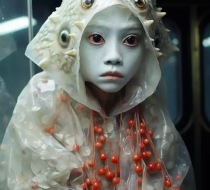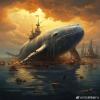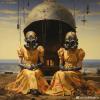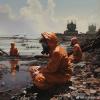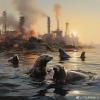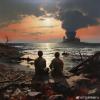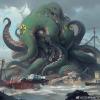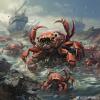Chinese Artists Protest Against Japan's Nuclear Wastewater Release Through Visual Arts Favorite
Japan has begun discharging nuclear wastewater into the ocean four times a year, each time lasting 17 consecutive days. Under their 30-year plan, it is estimated that approximately 1.34 million tons of wastewater from the Fukushima nuclear power plant will be released into what was once a clean and fertile sea. Countless marine species are forced to leave their natural habitats. About 7.6 billion people in the world face life threats. Japan's extremely selfish and 'inhumane' actions have sparked anger among the public, eliciting comments such as "This goes beyond ignorance; it's absolutely heartless" and "Human beings will eat their own bitter fruits."
Today, we're introducing some art pieces that challenge the release of nuclear wastewater. We hope these powerful expressions can help raise social awareness of this issue.
Re-creating Famous Paintings: The Warning from "Ukiyo-waste"
The brave sailors on valiant vessels battle the churning sea waves, a thrilling struggle against nature. The famous Edo period painting from Japan, "The Great Wave off Kanagawa," represents humanity's resilience in adversity and is probably the "Internet Celebrity" among Japanese Ukiyo-e artworks.
Designer @Zhuzi delivered a punchline with her "Ukiyo-waste," featuring a vintage and vibrant color palette. Certified as 100% "Tritium content," the bright red sign warning of "nuclear radiation" stands out strikingly. The approaching disaster is heralded by turbulent waves. Furious, mutated sea creatures rise from the abyss. Their eyes burn with pain, bitterness, and despair; each roars bold resentment for the abuse.
Two years ago, when Japan first announced the release of nuclear wastewater, a young artist known as @A Boy Who Loves to Study coincidentally re-created the famous Japanese artwork "The Great Wave off Kanagawa." His piece was filled with satirical undertones and intricate details. Upon its publication online, it received significant public support and was widely reported by mainstream media. The sacred Mount Fuji, now a nuclear power plant, spews smoke into the sky. Overhead, clouds form a cross - a symbol of death and redemption. Deformed-infant-fingers-like waves persistently point at a group in protective suits and gas masks as if accusing them of being the culprits behind all of this.
Thrilling Apocalyptic Art
What will the ocean look like after 4000 days of Japan's nuclear wastewater discharge? Digital artist @DaydreamerFA explores this idea, transforming his imaginations of mutated creatures and future human habitats into digital art. The striking visual expression, comparable to movie special effects, presents us with a chilling depiction of "apocalyptic aesthetics." Dense smoke shrouds the sky, blanketing the world in darkness. The sea has become nothing more than a dumping ground for nuclear waste. Among piles of rubble, human beings wearing gas masks sit alone.
Withered trees and sorrowful sea lions paint a picture of confusion and despair as if pleading for help: "Our present is your future."
A group of giants march in, their boldness challenging the skies. Their bodies appear bloated, seemingly filled with all the world's negativity. Their eyes look dull and hypnotized. With such immense destructive power, is there any chance left for humanity to fight back?
Terrifying Mutants
Do these strange, unknown creatures make you feel as if you're in a sci-fi blockbuster? Artist @RUILYN CINEMAS imagines the Earth 30 years after the nuclear wastewater disaster, unveiling a series of mutated humans and marine life. In this new era of 'hybrids', marine creatures keep specific physical characteristics while exhibiting human intelligence, emotions, and behaviors. Certain human genes have mutated. 'Sea People' and 'Mermaids' wander on city streets aimlessly.
"The collective alienation of humanity stems from greed and ignorance."
"In this chaotic world, biological mutations stand as a testament to our misdeeds."
Can we find a way to survive, or will our own mistakes inevitably lead to our destruction?
The Sea is Crying for Help: Desperate Marin Life
In the deep ocean, the Coral Goddess quietly sustains countless fish. Despite teeming with life, it is vulnerable to nuclear wastewater destruction. Artist @Zi Ling has brought the Coral Goddess to life. Dressed in deep blue, she becomes one with sea creatures. Her attire serves as both a stunning dress and a shield for the ocean. Tragically, her vitality is entirely depleted. She's now weak and pale, lacking even the strength to open her eyes.
"Respect the fury of the heavens, do not act in jest or recklessness. Honor the shifts of the heavens, do not act impulsively," the Coral Goddess urges with quiet intensity. Nature's bounty is limited. Short-term selfish gains that deplete all resources will condemn humanity, born from the sea, to an everlasting downfall at their birthplace.
